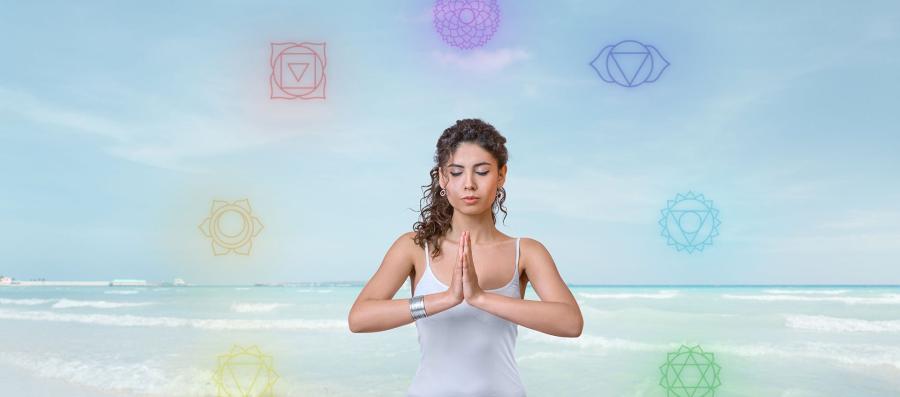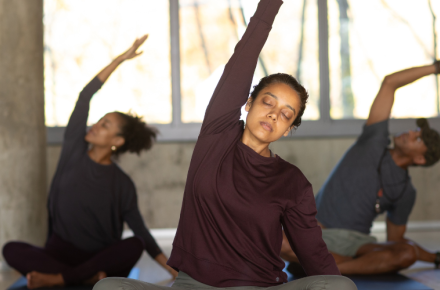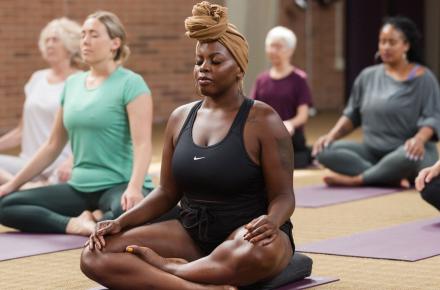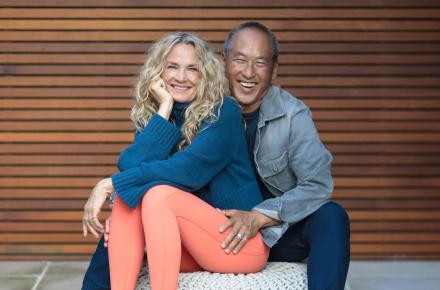Yoga for the Chakras


The seven chakras represent an ancient map that helps us understand how the physical body relates to the energetic body, the mind, and the spirit. Just as yoga postures address more than the physical body, working with the chakras brings awareness to physical issues, and also helps to identify and free up energetic and emotional blocks. When you experience a yoga pose through the lens of the chakras—drawing your focus to a physical location of the body and also to all the qualities and levels of awareness associated with that chakra—it makes the posture so much more potent.
One thing I love about integrating the chakras into my yoga teaching is how adaptable the practice is for all levels of experience. Focusing a practice around the chakras is not necessarily about doing advanced yoga postures; rather, it’s about bringing an advanced level of awareness to what might sometimes be familiar postures. It’s wonderful for beginners, as the chakras offer an accessible, specific way to work with postures. For experienced practitioners, adding this layer can offer a new way to approach their practice. Even after more than a decade of working with chakras, I find that they bring something fresh to poses that I’ve done a thousand times before.
Here are the seven chakras and a pose or practice that focuses on each one.
The First Chakra: Root—Muladhara
Element: Earth
Posture: Mountain
In working with the root chakra, we do postures that connect us physically and emotionally to the earth—dropping down not only through the tailbone, where this chakra is located, but also through the sitting bones, feet, and legs. Mountain pose is a beautiful posture for bringing focus to the first chakra. We physically embody the mountain, aligning ourselves with the earth and feeling stable, steady, grounded, and present.
The Second Chakra: Sacrum—Svadhisthana
Element: Water
Posture: Pigeon
The second chakra is associated with the qualities of flow. For many of us, the hips and low back—the physical location of the second chakra—are places where we often feel rigid or stuck, particularly because we spend so much of our lives sitting. Pigeon is a great pose for encouraging fluidity in this area—cultivating ease, softening, and flexibility. The second chakra is traditionally the home of the emotional body, and as prana starts to flow in this area, we might experience more intense emotions, but also greater ease in navigating those emotions.
The Third Chakra: Solar Plexus—Manipura
Element: Fire
Posture: Goddess
The third chakra is our center of strength, the core of the body. It’s connected to our vitality, vibrancy, and digestive fire. Goddess awakens heat and connects us to our strength, unleashing a sense of joy and confidence. Some of us tend to have a little too much fire (physically and emotionally) and some of us not enough; chakra work can give us tools to regulate that inner flame.
Fourth Chakra: Heart—Anahata
Element: Air
Posture: Bridge
All the time we spend hunched over our screens collapses the heart center and compresses the breath. Bridge pose opens up the chest, the upper back, the lungs, and the shoulders—the region of the fourth chakra—inviting in receptivity, openness, and connection. While in Bridge, you might practice a soothing pranayama like Ujjayi or practice consciously bringing the breath into the heart space, expanding the lungs and chest cavity. Fourth-chakra poses bring lightness to the heart, and therefore are beneficial for depression.
Fifth Chakra: Throat—Vishuddha
Element: Sound
Practice: Lion’s Breath
As we start to move up into the fifth, sixth, and seventh chakras, it becomes less about what postures we’re doing and more about the qualities we’re accessing. In the fifth chakra, that quality is sound, and we can add sounding to almost any posture. One great sounding practice is Lion’s Breath, in which we open the throat and let go of tension in the jaw—releasing constraints around the voice and self-expression. Lion’s Breath can be done in Easy pose, sitting on your heels, or in any other posture that lends itself to the practice.
Sixth Chakra: Third Eye—Ajna
Element: Light
Posture: Child’s Pose
The sixth chakra is our inner lighthouse, our intuition—the still, small voice within. We have two eyes that look out, and the third eye’s job is to look inward. Located between the eyebrows, it’s energetically linked to the pineal gland at the center of the brain, which helps maintain our circadian rhythms—our response to light. For this chakra, it’s again not so much about the posture itself but rather about the quality of attention we bring to it, cultivating clarity and focus. A lovely way to practice this is in Child’s pose with the forehead on the earth. Bring awareness to the third eye, observing the thoughts passing through the mind, and envision yourself simply being here, now, fully aware in this moment.
Seventh Chakra: Crown—Sahasrara
Element: Ether
Posture: Savasana
The crown chakra is connected to space, spirit, the infinite, all the invisible mysteries of the universe. Moving into a deep, meditative Savasana is a beautiful way to focus on the seventh chakra, cultivating stillness and receptivity and finding your own way to access the Divine—whatever that means to you.
Find out about Jurian’s Chakra Immersion at Kripalu.
© Kripalu Center for Yoga & Health. All rights reserved. To request permission to reprint, please e-mail editor@kripalu.org.














































